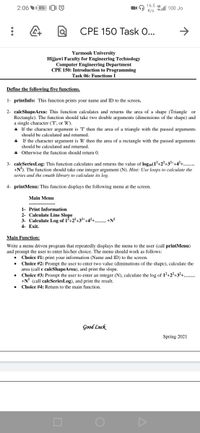
Computer Networking: A Top-Down Approach (7th Edition)
7th Edition
ISBN: 9780133594140
Author: James Kurose, Keith Ross
Publisher: PEARSON
expand_more
expand_more
format_list_bulleted
Question

Transcribed Image Text:2:06 85 0I ©
16.5 66 l 100 Jo
K/s
CPE 150 Task 0...
Yarmouk University
Hijjawi Faculty for Engineering Technology
Computer Engineering Department
CPE 150: Introduction to Programming
Task 06: Functions I
Define the following five functions.
1- printInfo: This function prints your name and ID to the screen.
2- caleShapeArea: This function calculates and returns the area of a shape (Triangle or
Rectangle). The function should take two double arguments (dimensions of the shape) and
a single character (T', or 'R').
If the character argument is T' then the area of a triangle with the passed arguments
should be calculated and returned.
If the character argument is 'R' then the area of a rectangle with the passed arguments
should be calculated and returned.
* Otherwise the function should return 0.
3- caleSeriesLog: This function calculates and returns the value of log1o(1²+2²+3²*+4²+...
+N). The function should take one integer argument (N). Hint: Use loops to calculate the
series and the cmath library to calculate its log.
4- printMenu: This function displays the following menu at the screen.
Main Menu
1- Print Information
2- Calculate Line Slope
3- Calculate Log of 1+2°+3*+4²+.... +N?
4- Exit.
Main Function:
Write a menu driven program that repeatedly displays the menu to the user (call printMenu)
and prompt the user to enter his/her choice. The menu should work as follows:
Choice #1: print your information (Name and ID) to the screen.
Choice #2: Prompt the user to enter two value (diminutions of the shape), calculate the
area (call c calcShapeArea), and print the slope.
Choice #3: Prompt the user to enter an integer (N), calculate the log of 12+2?+3+....
+N° (call caleSeriesLog), and print the result.
Choice #4: Return to the main function.
Good Luck
Spring 2021
Expert Solution
This question has been solved!
Explore an expertly crafted, step-by-step solution for a thorough understanding of key concepts.
Step by stepSolved in 4 steps with 3 images

Knowledge Booster
Similar questions
- Fill in the Blank Word GameThis exercise involves creating a fill in the blank word game. Try prompting the user to enter a noun,verb, and an adjective. Use the provided responses to fill in the blanks and then display the story.First, write a short story. Remove a noun, verb, and an adjective.Create a function that asks for input from the user.Create another function that will fill the blanks in the story you’ve just created.Ensure that each function contains a docstring.After the noun, verb, and adjective have been collected from the user, display the story that has beencreated using their input. use python to ode.arrow_forwardPlease Write a function to validate please make the code in java like this function validate() {document.getElementById} ETC. if the numbers were 1 through 9 if there is a name if email is valid if cell phone i valid if Card number, EXP date and CVV is valid or not if the address is valid or not Below is the html please make the java code as simple as posible also when ever its false can you make the text print on the bottem saying "this code is valid" once i press the submite button <div class="g"> <div class="n"> <div class="r"> <img class="a" src="#"> <div class="p">+</div> <form id="result" action="#"> <input type="text" id="number" placeholder="Choose from item 1-9"> <input type="text" id="name" placeholder="Name"> <input type="email" emailplaceholder="E-mail@gmial.com" id="email">…arrow_forwardassign(self, assignment:Assignment) -> AssignmentResult: """ This function is to simulate the process of the student receiving an assignment, then working on the assignment, then submitting the assignment and finally receiving grade for the assignment. This function will receive an assignment then a grade should be calculated using the following formula: grade = 1 - (Student's current energy X Assignment difficulty level). The min grade a student may receive is 0% (0) After the grade is calculated the student's energy should be decreased by percentage difficulty. Example if the student has 80% (.8) energy and the assignment is a difficultly level .2 there final energy should be 64% (.64) = .8 - (.8 * .2). The min energy a student may have is 0% (0) Finally the grade calculated should be stored internally with in this class so it can be retrieved later. Then an Assignment Result object should be created with the student's ID, the assignment…arrow_forward
arrow_back_ios
arrow_forward_ios
Recommended textbooks for you
 Computer Networking: A Top-Down Approach (7th Edi...Computer EngineeringISBN:9780133594140Author:James Kurose, Keith RossPublisher:PEARSON
Computer Networking: A Top-Down Approach (7th Edi...Computer EngineeringISBN:9780133594140Author:James Kurose, Keith RossPublisher:PEARSON Computer Organization and Design MIPS Edition, Fi...Computer EngineeringISBN:9780124077263Author:David A. Patterson, John L. HennessyPublisher:Elsevier Science
Computer Organization and Design MIPS Edition, Fi...Computer EngineeringISBN:9780124077263Author:David A. Patterson, John L. HennessyPublisher:Elsevier Science Network+ Guide to Networks (MindTap Course List)Computer EngineeringISBN:9781337569330Author:Jill West, Tamara Dean, Jean AndrewsPublisher:Cengage Learning
Network+ Guide to Networks (MindTap Course List)Computer EngineeringISBN:9781337569330Author:Jill West, Tamara Dean, Jean AndrewsPublisher:Cengage Learning Concepts of Database ManagementComputer EngineeringISBN:9781337093422Author:Joy L. Starks, Philip J. Pratt, Mary Z. LastPublisher:Cengage Learning
Concepts of Database ManagementComputer EngineeringISBN:9781337093422Author:Joy L. Starks, Philip J. Pratt, Mary Z. LastPublisher:Cengage Learning Prelude to ProgrammingComputer EngineeringISBN:9780133750423Author:VENIT, StewartPublisher:Pearson Education
Prelude to ProgrammingComputer EngineeringISBN:9780133750423Author:VENIT, StewartPublisher:Pearson Education Sc Business Data Communications and Networking, T...Computer EngineeringISBN:9781119368830Author:FITZGERALDPublisher:WILEY
Sc Business Data Communications and Networking, T...Computer EngineeringISBN:9781119368830Author:FITZGERALDPublisher:WILEY

Computer Networking: A Top-Down Approach (7th Edi...
Computer Engineering
ISBN:9780133594140
Author:James Kurose, Keith Ross
Publisher:PEARSON

Computer Organization and Design MIPS Edition, Fi...
Computer Engineering
ISBN:9780124077263
Author:David A. Patterson, John L. Hennessy
Publisher:Elsevier Science

Network+ Guide to Networks (MindTap Course List)
Computer Engineering
ISBN:9781337569330
Author:Jill West, Tamara Dean, Jean Andrews
Publisher:Cengage Learning

Concepts of Database Management
Computer Engineering
ISBN:9781337093422
Author:Joy L. Starks, Philip J. Pratt, Mary Z. Last
Publisher:Cengage Learning

Prelude to Programming
Computer Engineering
ISBN:9780133750423
Author:VENIT, Stewart
Publisher:Pearson Education

Sc Business Data Communications and Networking, T...
Computer Engineering
ISBN:9781119368830
Author:FITZGERALD
Publisher:WILEY